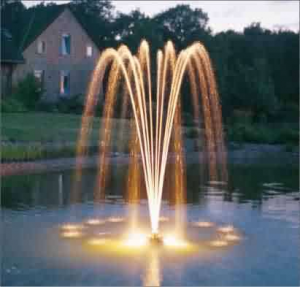Fountain pumps are constructed to make the flow of water available to fountains and devices used for decorative purposes and aeration in residential, industrial, and commercial use. Fountain pumps are designed for indoor and outdoor use. They are commonly distinguished based on the size of the pool or pond and whether it is for decorative or functional application. Some fountain pumps can work by using solar power. They can even create a special garden or landscape design like waterfalls.
Table of Contents
Types
Fountain pumps can be categorized into different types based on various factors, such as – application, operating method, and whether the pump is submerged or external.
Operation
All pumps operate either on the dynamic or positive displacement principle. Dynamic pumps use fluid thrive and velocity to generate pump pressure, whereas positive displacement pumps utilize increasing and decreasing cavities to maintain the flow of fluids. Dynamic pumps generate a variable flow suitable for producing high flow rates with low viscidity fluids. Positive displacement pumps generate a constant flow suitable for producing low flow rates and high pressures with high viscidity fluids.
Fountain pumps are mostly centrifugal pumps as they move water using pressure from the centrifugal force generated by the momentum of an impeller. It functions like a sump pump, excluding the fact that the water is fed back into the pond or reservoir instead of out of it. Nowadays, there are various companies from where we can order pumps for fountains.
Application
Based on applications, fountain pumps can be subclassified into two types, namely, – commercial and industrial.
1. Commercial
Fountain pumps are mostly used for aesthetic purposes, like garden and tabletop fountains. They come in a variety of designs, including indoor and outdoor pumps. The fountain machinery for decorative fountain pumps is held in an above-ground reservoir or sump instead of a pond or pool.
2. Industrial
For industrial purposes, fountain pumps are utilized to aerate wastewater generated from manufacturing processes to treat sewage water or water for municipal use. They are also used to circulate stagnant water to avoid the accumulation of algae or the breed of mosquitoes. They are designed to offer high flow rates and pressures for different purposes.
External vs Submersible
Fountain pumps can be either submersible or external-
Submersible pumps – They have the pump motor completely sealed in the pump body. This allows the whole system to be immersed within the water reservoir or water source. It is comparatively easy to install these pumps as compared to external pumps. Moreover, they are less costly.
External pumps – These pumps are quite difficult to install but are more efficient. They are suitable to manage the backpressure related to the use of a pressurized external filter. They are easy to clean and repair.
Specifications
Here are some of the primary specifications which need to be considered while selecting fountain pumps-
• Flowrate – It defines the rate of the volume dispensed through the pump, mostly given in gallons per minute or gallons per hour.
• Head – It describes the energy generated to liquid by the pump. It is indicated as a column height of fluid, given in feet of head.
• Pressure – It defines the operational pressure of the pump. It is usually expressed in pounds per square inch or bar.
• Horsepower – It describes the output power of the pump. It is expressed in units of horsepower.
• Power rating – It describes how much power is required to operate the pump. It is measured in Watts or horsepower.
• Outlet diameter – It is the size of the outlet connection of the pump. It indicates the whole opening size, comprises the pipe or nozzle thickness.
• Inner diameter – It is the size of the inner opening.
Matching Pump Specifications to the Application
The size of fountain pumps must be such that it fits the needs of the reservoir, fountain, or pond they are servicing. It includes the following considerations:
• Turning – It means to cycle all of the water from the reservoir with the help of the pump.
• Selection Tip – Turn the water every two hours for the ponds with a pressurized filter.
• Pipe sizing – Select the pipes and tubes which can fit the pump and allow proper flow. If the pipe sizes are too small, it will restrict flow, whereas pump sizes that are too large will lead to an insufficient outlet speed.
• Total head – To specify the pump head requires identifying the total head of the system. This can be determined from various factors, like friction and elevation.
Conclusion
Fountain pumps offer a flow of water to fountain tubing and other applications. They are utilized for either functional or ornamental use. They can be used whenever we need to replace an existing fountain pump or when we desire to make our stagnant pond stand out.
